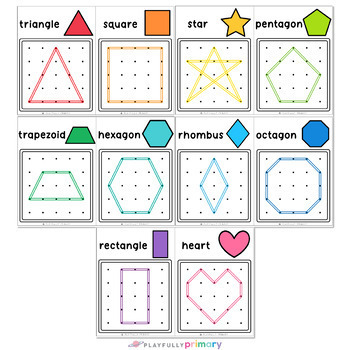Geoboard Task Cards, 2D Shapes Geoboard Printable Activity Patterns
- PDF
What educators are saying
Description
Geoboard Task Cards, 2D Shapes Geoboard Printable Activity Patterns
If you're searching for some geoboard activities, you should definitely take a look at this geoboard patterns printable. These geoboard task cards showcase vibrant 2D shapes and come in two levels of difficulty, making them ideal for strengthening fine motor skills and hand-eye coordination.
Students simply select a card and use rubber bands to recreate the 2D shape on the geoboard. If they want to practice writing shape names, there are optional recording worksheets included as well.
Geoboard shapes task cards - Two levels included:
triangle
square
star
pentagon
trapezoid
hexagon
rhombus
octagon
rectangle
heart
Thoughtfully created for:
Preschool
Pre-K
TK
Kindergarten
Homeschool
Montessori
Occupational Therapy
Special Education
Daycare
✨You may also like:
Alphabet Fine Motor Activities
Holiday + Seasonal Fine Motor Activities
✨Tips:
∙ Rate and review to earn TPT credits toward your next purchase.
∙ You can always find your downloads here: www.teacherspayteachers.com/My-Purchases.
∙ Use Adobe Reader on your computer and make sure it’s updated to the latest version, which can be downloaded for free at get.adobe.com/reader.
✨License + Terms of Use:
∙ By downloading this product, you agree that this digital download is the property of Playfully Primary and is licensed to you, the purchaser, strictly for personal home use or single classroom use only and can not be resold or redistributed in any other capacity. Playfully Primary retains the copyright and reserves all rights to this product.
∙ You may use this product for personal or classroom use.
∙ You may not use it for any commercial purpose, claim this work as your own, sell, copy, alter, or share this product with others.
✨Thank you for stopping by!
♡ Don’t forget to follow my shop to receive updates on new items and discounts! www.teacherspayteachers.com/Store/Playfully-Primary
Geoboard Task Cards, 2D Shapes Geoboard Printable Activity Patterns





